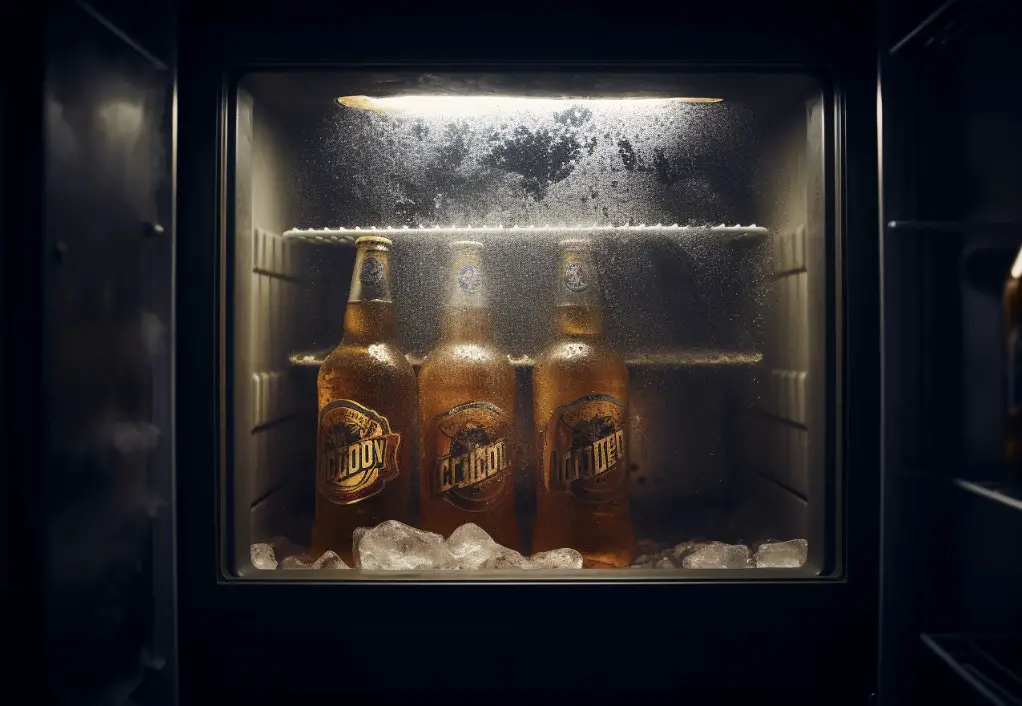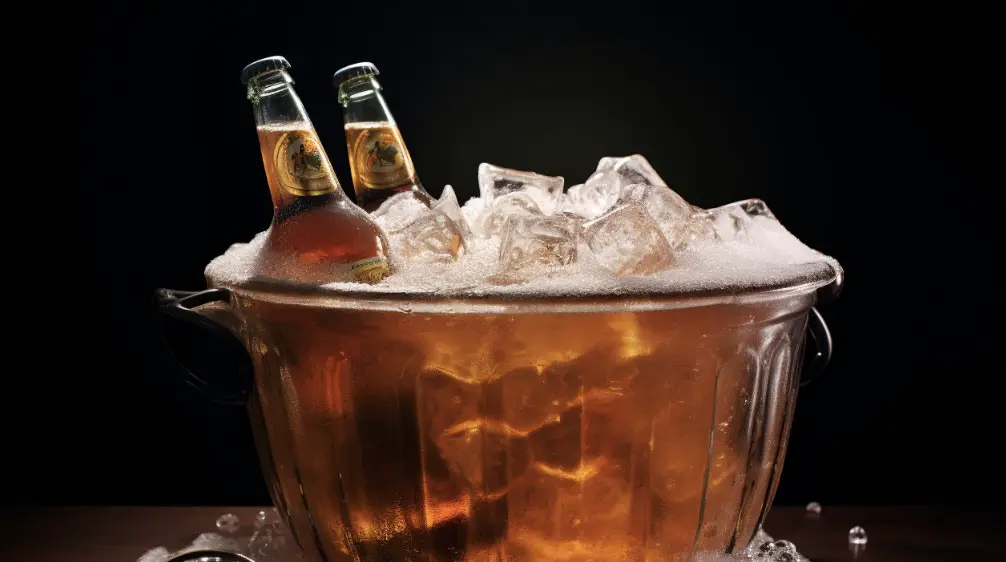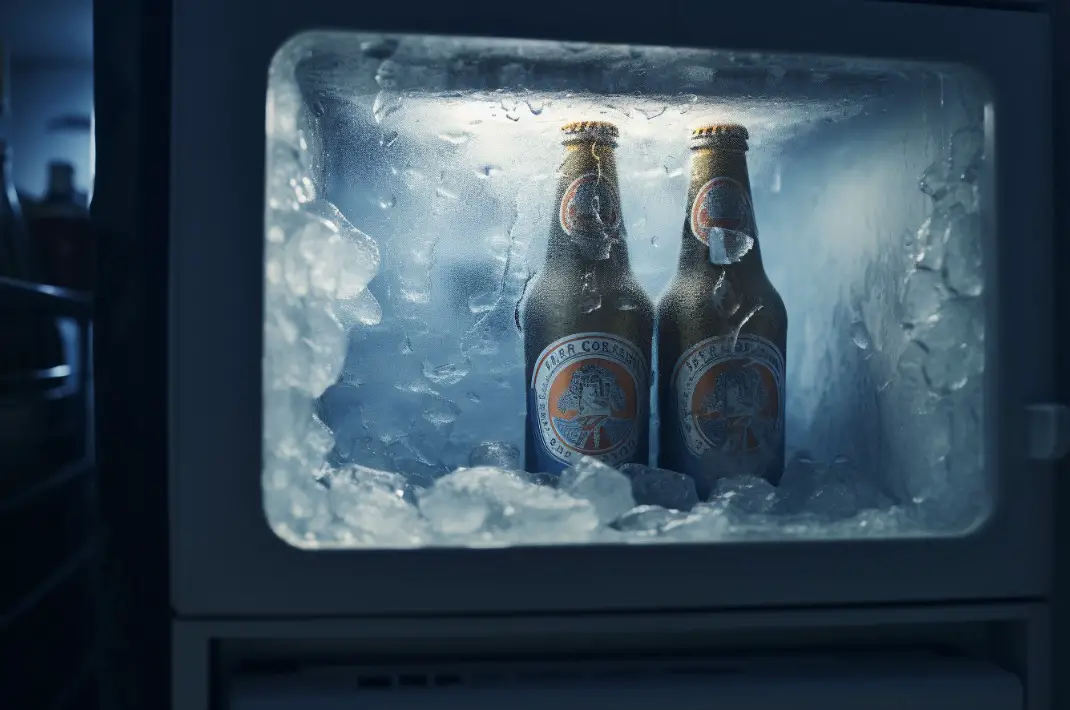Have you ever found yourself with a warm beer in hand, impatiently waiting for it to chill in the freezer? We’ve all been there, and the question on everyone’s mind in such a moment is: How long does it take for beer to get cold in the freezer?
The answer is that it takes approximately 20-25 minutes for a beer to get to a reasonable drinking temperature in the freezer.
But the timing can vary depending on several factors, including the type of beer, the size of the bottle or can, and the temperature of your freezer.
In this post, I’m going to delve into this topic more deeply, drawing from my personal experience as a brewer and beer enthusiast. I’ll also provide some tips on how to chill your beer more efficiently.
The Science of Chilling Beer
To understand how beer gets cold, it’s helpful to know a bit about the science behind it. In simple terms, the freezing point of beer is lower than that of water, due to its alcohol content. This is why beer takes longer to freeze than water.

Additionally, the process of heat transfer plays a crucial role. Initially, the heat from the beer is transferred to the air in the freezer.
However, as the beer cools down, the heat transfer slows, making the last part of the cooling process the longest.
Factors Affecting the Cooling Time
1. Size and Type of Container
The size and type of the beer container can significantly affect cooling time. A smaller can will chill faster than a larger bottle because of its smaller volume and larger surface area.

Similarly, cans often chill faster than bottles because aluminum conducts heat more efficiently than glass.
2. Initial Temperature of the Beer
The initial temperature of your beer also plays a role. If you’re cooling a beer that’s been sitting in a hot car, it’s going to take longer than a beer that’s been at room temperature.
3. The Freezer’s Temperature
The colder your freezer, the faster your beer will chill. Most home freezers are set at around -18°C (0°F). At this temperature, a standard 355 ml (12 fl oz) can of beer will take about 20-25 minutes to cool to a pleasant drinking temperature.
Tips for Chilling Beer Faster
Wet Paper Towel Trick
One of my favorite tricks to chill beer faster involves wrapping the beer in a wet paper towel before putting it in the freezer. The water in the paper towel evaporates while the beer cools, a process that draws heat away from the beer, cooling it more quickly.
Make Use of a Salted Ice Bath
If you have more time and resources at hand, consider using a salted ice bath. The salt lowers the freezing point of the water, allowing it to get colder than ice alone, and thus chill your beer faster.

The Risk of Freezing
One thing you need to be cautious about when chilling beer in the freezer is forgetting about it. If left in the freezer too long, beer can freeze, and expanding beer can lead to an exploded can or bottle in your freezer, which is a mess nobody wants to clean up.

Fastest Way To Chill A Beer?
Cooling down a beer involves transferring its heat to the surrounding environment.
The rate of this heat transfer depends on several factors, including the temperature difference between the beer and its environment, the medium it’s in contact with, and the properties of that medium.
Let’s break down the science step-by-step:
- Cooling in a Freezer:
- Air as a medium: When you place a beer in the freezer, it’s surrounded by cold air. Air is a poor conductor of heat compared to liquids or solids. This is because air molecules are more spread out, so there are fewer molecules to carry away heat via conduction.
- Convection: However, as the air near the beer can gets cooler, it becomes denser and drops, allowing warmer air to come in contact with the beer. This process is called convection. In a freezer, there is some amount of convection, but it’s often limited due to the confined space and the lack of significant airflow.
- Cooling in an Ice Bucket:
- Water as a medium: When ice melts in the bucket, you get a slurry of ice and water. Water is a much better conductor of heat than air because its molecules are closer together, allowing them to more efficiently absorb and transfer heat. When you submerge a beer can in this slurry, it’s making direct contact with a medium that can absorb heat faster than air, speeding up the cooling process.
- Surface area and contact: The irregular shapes of ice cubes also ensure that there’s more surface area in contact with the beer, and this increased contact area enhances the rate of heat transfer.
- Ice Bucket with Salt Added:
- Lowering the freezing point: Adding salt to the ice causes the ice to melt at a lower temperature than it normally would. This is because the dissolved salt disrupts the structure of the ice, making it harder for the water molecules to form solid ice. As a result, you can get a solution that’s colder than the normal freezing point of water (0°C or 32°F).
- Endothermic melting: When ice melts, it absorbs heat from its surroundings in a process called an endothermic reaction. By adding salt and causing more ice to melt, you’re essentially “boosting” the amount of heat being absorbed from the beer, making it cool down faster.
- Increased convection: The melting of ice with salt creates a denser, colder brine that sinks to the bottom of the bucket. This movement promotes convection, ensuring that colder water is always in contact with the beer, further increasing the rate of cooling.
In summary:
- Air in the freezer is a poor heat conductor, so it cools the beer down slower than a direct contact with a liquid.
- Water is better at conducting heat away from the beer because its molecules are closer together, enabling more efficient heat transfer.
- Salt speeds up the process by lowering the freezing point of water, causing more ice to melt and absorb heat, and promoting convection in the ice-water mixture.
So, if you’re looking for the quickest way to cool your beer, an ice bucket with salt added is the way to go!
Conclusion
So, how long does it take for a beer to get cold in the freezer? Around 20-25 minutes is a good estimate, but remember, this can vary based on factors like the size and type of the container, the initial temperature of the beer, and the temperature of your freezer.
Try out some of our tips to chill beer faster and always remember to set a timer to avoid a beer explosion in your freezer.
To sum up, here are 10 key facts about chilling beer:
1. The freezing point of beer is lower than that of water, because of its alcohol content.
2. Heat transfer slows down as beer cools, making the last part of the process the longest.
3. A smaller can will chill faster than a larger bottle due to its smaller volume and larger surface area.
4. Aluminum cans often chill faster than glass bottles.
5. The initial temperature of your beer affects how long it takes to cool.
6. The colder your freezer, the faster your beer will chill.
7. Wrapping beer in a wet paper towel before freezing can speed up the cooling process.
8. A salted ice bath can also be used to chill beer quickly.
9. Leaving beer in the freezer too long can cause it to explode.
10. The estimated time for a beer to get cold in the freezer is around 20-25 minutes.
FAQs
How do you cool a drink quickly in the freezer?
To cool a drink quickly in the freezer, follow these steps:
1. Ensure that the drink is in a container that is freezer-safe and tightly sealed to prevent any spills or contamination.
2. Clear some space in your freezer to accommodate the drink container.
3. Place the drink container in the freezer, making sure it is positioned in a way that allows maximum exposure to the cold air.
4. Leave the drink in the freezer for approximately 15-20 minutes, or until desired coldness is achieved. Be cautious not to leave it for too long, as it may freeze and potentially explode the container.
5. Once the drink has reached the desired temperature, remove it from the freezer and enjoy.
Remember to monitor the drink’s cooling progress to avoid over-freezing or forgetting it in the freezer.
Does beer get colder faster in the freezer or in ice?
Beer will get colder faster in the freezer compared to being placed in ice. The freezer provides a more direct and intense cooling effect due to its lower temperature, allowing the beer to chill more rapidly.
How long does it take to chill a drink in freezer?
The time it takes to chill a drink in the freezer can vary depending on several factors, including the initial temperature of the drink, the size of the container, and the temperature of the freezer. However, on average, it typically takes about 1-2 hours for a drink to become noticeably chilled in a standard home freezer.
Is it faster to cool a drink in the fridge or freezer?
It is faster to cool a drink in the freezer rather than the fridge. The freezer has lower temperatures, allowing for quicker heat transfer and faster cooling of the drink.
How long does it take for a drink to cool in the freezer?
The time it takes for a drink to cool in the freezer can vary depending on several factors. Generally, a drink will start to cool down within a few minutes, but it may take around 20-30 minutes to reach a noticeably colder temperature. However, it’s important to keep an eye on the drink to prevent it from freezing solid, as this can take a couple of hours or more depending on the freezer’s temperature setting.
How long does it take for a beer to get cold in the fridge?
The time it takes for a beer to get cold in the fridge can vary depending on several factors. Generally, a beer can reach a cold temperature within 30 minutes to an hour in a standard refrigerator set at around 40°F (4°C). However, factors like the initial temperature of the beer, the type of container, and the efficiency of the fridge can impact the cooling time.




